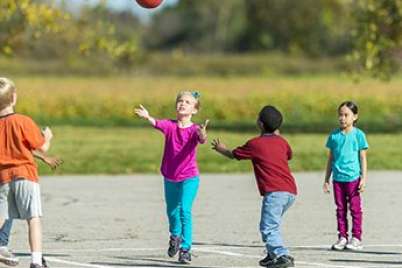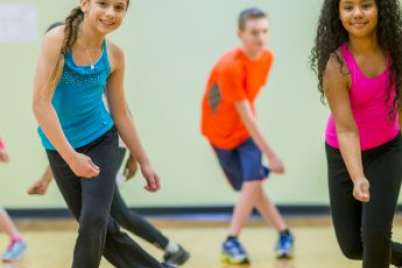
10 helpful tips if your child “hates” PE class
For many kids, physical education class (also called PE class or gym class) is the best part of the school day. And what’s not to love? They get to run around and play games with their friends. For some kids, however, PE class is the worst part of their day. Simply the idea of PE sets their tummies aflutter and teeth on edge. If your child “hates PE class” I’m here to help. Not only was that child me, but I’ve helped my own child through this struggle. In this article, you’ll find 10 helpful tips to support your child in becoming more comfortable and confident with PE class.
I was that child. I hated PE class!
In kindergarten, I loved PE class, but by late elementary, I hated it. What happened? Throughout elementary school, I was always the smallest girl in my class. I soon learned that my small stature was a disadvantage. I couldn’t jump high enough, throw far enough, or run fast enough to keep up to my peers, which made me the last pick of the team. Eventually, I started to view myself as “not athletic” and I approached PE class with trepidation and anxiety. In fact, I would look for any opportunity to skip out, even begging my mother to write me notes of exemption.
Tools for supporting your anxious child
My story is not unique. Many children dislike PE class, but it doesn’t have to be that way. While there are a number of reasons why kids might hate gym class, most can develop the confidence and skills they need with some guidance from a parent, teacher, or trusted adult. The following 10 tips are a framework for helping your child make that journey.
1. Listen attentively
When a child proclaims that they “hate gym class” there are a few typical responses—the comment is missed, dismissed, misunderstood, or judged. These responses aren’t ideal but, coming from busy parents, they’re common. After all, kids can hate peas one day then gym class the next. As a parent, it can be difficult to navigate the dislikes of your child day-to-day. However, if your child suddenly shares that they hate gym class, this is your cue to listen attentively.
2. Respond with care and empathy
Perhaps you struggled with gym class as a child, or maybe you were an all-star school athlete. Regardless of your own past experiences, respond to your child with care and empathy. Try saying something simple like:
- It sounds like gym class has been difficult for you today—I’m sad to hear that.
- I can tell that you feel very upset about PE class.
3. Discover the “why”
After taking time to listen attentively and respond with care, your child may be willing to share the reasons behind their gym class dislike. Try asking some open-ended questions to get the ball rolling:
- Did something happen in PE class that made you feel that way?
- How long have you felt like that about PE class?
- Do you always feel that way about PE class, or just sometimes?
4. Rule out medical conditions
Sometimes the why behind PE class anxiety can be an underlying medical issue that can be easily missed but can make a big difference when properly addressed. As a young child, my eldest son hated running. I figured he was being obstinate or lazy, which was a big misjudgement! It turned out that he had exercise-induced asthma and overpronated feet (flat feet) that made running difficult and painful. With proper treatment, he went from avoiding physical activity to enjoying it.
If your child is complaining about being out of breath or having sore knees, achy feet, or other physical ailments brought on by PE activities, be sure to have your child checked by a doctor or physiotherapist.
5. Address mental health concerns
Twenty percent of Canadian kids will experience a mental illness. If your child experiences anxiety or worry in other areas of learning and living, PE class anxiety might be only a small piece of a bigger puzzle. As a parent of an anxious child, I know how important it is to seek help, the earlier the better, to give your child the tools they need to help manage their mental illness. If you suspect this might be the case, please connect with your healthcare provider to find helpful resources.
6. Communicate with the gym teacher
Gym teachers are usually happy to tell you how your child is doing in their class. Perhaps they have a hunch that something is amiss, but sometimes they don’t. It can be helpful to open up communication and brainstorm some ideas for helping your child enjoy PE class.
7. Encourage a growth mindset
The way a child thinks about a difficult experience can make it better or worse. Encouraging your child to adopt a growth mindset about PE class can be a powerful way to help them navigate through their struggle in a positive way. Helping your child realize that failure is a part of learning, perseverance is key, that there is always room for improvement, and that resilience is a superpower will help them in developing a growth mindset. If the idea of a growth mindset is new to you and your child, I suggest checking out this blog post from Big Life Journal.
8. Practice physical literacy at home
If your child’s dislike of PE class stems from a lack of confidence in their skills, make it a priority to practice those skills outside of class. Toss, kick, or dribble a ball in your driveway or at your local park together. Practicing and having fun together will boost your child’s self-confidence. Check out this great list of fun activities that will help your child develop fundamental movement skills.
9. Explore individual sports
Look beyond PE class and team sports to help your child develop skills and self-confidence. In my early teenage years I started rock climbing and it gave me a new way to see myself as strong and athletic, despite being small. Every child is uniquely made and individual sports can give children the opportunity to find something that fits. My eldest son is muscular and excels at Olympic weightlifting while my daughter is very petite (like myself) and thrives at dance. When kids have the opportunity to explore and excel in an individual sport, it can change their self-perception in a very positive way.
Some individual sports that your child might be interested in are:
- Indoor rock climbing
- Running
- Biking (road, trail, BMX)
- Swimming or diving
- Triathlons (swim, bike and run!)
- CrossFit for kids
- Martial arts
- Figure skating or speed skating
- Golfing
- Fencing
- Dancing (hip hop, acro, ballet, jazz, highland, etc.)
- Raquet sports (tennis, table tennis, squash, pickleball)
- Roller skating
- Skateboarding
- Hiking
- Skiing or snowboarding
10. Be a good role model
The way that you care for your body speaks loudly to your child. We parents often don’t prioritize staying physically active because we’re too busy. I’m definitely guilty of making this excuse. However, the Canadian 24-Hour Movement Guidelines recommend that adults ages 18 to 64 get at least 150 minutes of moderate to vigorous aerobic physical activities every week. That’s only about 20 minutes per day and there are many creative ways to incorporate active time during your day. Here are some ideas for how to get active when you’re a non-sporty parent or check out this article to discover an active parenting style that works for you and your family.
Moving beyond “hating” PE class
Helping your child navigate through the challenge of “hating” PE class takes time, effort, and patience. At the end of the day, it’s more than worth it because developing a love of movement will give your child the confidence and capability to be active and stay active for life.





